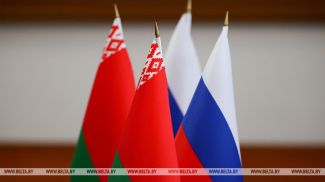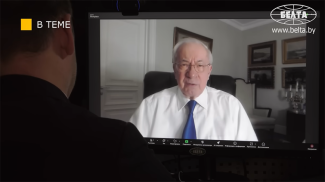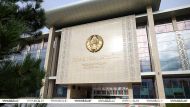MINSK, 5 August (BelTA) – Preparations for the Belarusian-Russian strategic army exercise Zapad 2021 [West 2021] proceed in a complicated global military and political situation, BelTA learned from Chief of the General Staff of the Armed Forces, First Deputy Defense Minister of Belarus Viktor Gulevich during a media briefing on 5 August.
Viktor Gulevich said: “Preparations for the exercise proceed in a complicated military and political situation in the world as a whole and the European region in particular. I think you can perfectly see it yourselves. Against the backdrop of lingering and resumed military conflicts in various parts of the planet Belarus is intent on minimizing the emergence of military threats in Eastern Europe, puts maximum effort into reducing tensions in the region, and pursues a peaceful and open policy. I hope today we will be able to reach objective understanding and an adequate evaluation of the forthcoming event. The information to be presented during the media briefing will once again reaffirm Belarus' eagerness to preserve stability and maintain good neighborly relations in the region.”
In his words, NATO's forward command centers were set up near western borders of the Union State of Belarus and Russia in the last few years. A forward operations group of the staff of the 5th army corps of the U.S. ground forces has been operating in Poland since late 2020. The strength of NATO's initial response forces has been raised to 40,000 people. NATO's four multinational battalion tactical groups are now fully operational. Foreign military contingents in Poland and the Baltic states alone count over 8,500 military personnel, about 120 tanks, over 230 armored fighting vehicles, about 70 artillery and MLRS systems, and over 30 combat aircraft and helicopters. The USA's initiative Four Thirties, which was adopted at a NATO summit in 2018, is being implemented fast. In line with the initiative 30 mechanized battalions, 30 air squadrons, and 30 combat vessels have to be readied and subordinated to the NATO joint forces coalition command within 30 days. “Together with initial response forces and four U.S. brigade battle groups it will allow NATO to concentrate a ground force of up to 100,000 people near our borders within a short period of time,” the chief of the General Staff of Belarus' Armed Forces said.
Hardware and installations in the territories Belarus borders on are being actively improved, including special warehousing facilities for storing and maintenance of weapons, military and special hardware, for storing supplies, materiel, and ammunition for the U.S. army. NATO exercises are held in the direct vicinity of the Belarusian border with a high intensity. These exercises focus on troops redeployment, preparation of travel routes and combat mission areas, the creation of battle groups, the establishment of bridges, assault river crossings, assault landings, and many other actions an offensive operation involves.
NATO's large-scale exercise Defender Europe was supposed to take place near borders of the Union State of Belarus and Russia in 2020. The exercise was supposed to bring together about 37,000 people as military contingents from 18 countries. Only the coronavirus pandemic forced them to reduce the scale of the event, the number of participants, and the number of areas for holding the exercise. Despite that the intensity of combat training events of NATO member states and partner states, the amount of troops and various weapon systems, which are deployed for such exercises, remain rather high. This year's Defender Europe exercise gathered over 40,000 people from 24 countries and the areas for hosting the exercise were shifted to the southeastern part of the region. At the same time a number of combat training exercises involving military contingents from 15 countries with the total troop strength of over 20,000 people took place in Poland and the Baltic states. “We understand that the organization of military exercises is part of troops training. However, their nature and the rising intensity cannot but raise concerns particularly after a number of provocative actions on the part of our Western neighbors,” Viktor Gulevich said.
The Belarusian-Russian strategic army exercise Zapad 2021 is a scheduled one and represents the final stage in the joint training of Belarusian and Russian armed forces this year. It is primarily designed to increase training levels of the regional military group, which is meant to ensure security in the Eastern Europe region.
In line with the training plan the exercise will take place in Belarus and nine army exercise areas in Russia on 10-16 September. The concept of the exercise is purely defensive. The concept was developed taking into account modern approaches to the deployment of forces (troops) based on the experience of recent armed conflicts, combat training events, and troops deployment forms and methods, which have been worked out by the Belarusian army and the Russian one.













